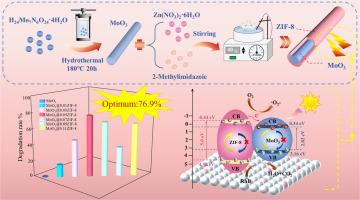MoO3@ZIF-8可见光下降解有机染料的核壳光催化剂
IF 6.3
3区 工程技术
Q1 ENGINEERING, CHEMICAL
Journal of the Taiwan Institute of Chemical Engineers
Pub Date : 2025-09-29
DOI:10.1016/j.jtice.2025.106433
引用次数: 0
摘要
半导体和金属有机骨架复合材料在光催化领域,特别是在环境污染治理方面开辟了一个很有前途的研究方向。尽管MoO3和ZIF-8在光催化方面的研究非常广泛,但由于单组分体系中电荷载流子的快速重组,它们在可见光下的有机污染物降解效率仍然受到限制。方法以MoO3纳米棒为半导体,ZIF-8为MOF,采用搅拌法制备MoO3@MOF核壳纳米复合材料。理化表征结果证实了ZIF-8在MoO3纳米棒表面的成功生长。通过评价MoO3@ZIF-8在可见光下对罗丹明B (Rhodamine B, RhB)溶液的降解,分析了其光催化性能。MoO3@ZIF-8表现出比纯MoO3或ZIF-8更好的降解和光催化活性。在可见光照射120 min后,RhB的降解率达到83.6%。MoO3@0.05ZIF-8(合成ZIF-8的每种试剂的质量为0.05 g)的吸附量在复合材料中最高,达到28.9%。这种增强的性能源于MoO3-ZIF-8的协同相互作用,表明该复合材料具有光催化降解有机污染物的潜力。本文章由计算机程序翻译,如有差异,请以英文原文为准。

MoO3@ZIF-8 core–shell photocatalysts for the degradation of organic dye under visible-light irradiation
Background
Composites of semiconductors and metal–organic frameworks (MOFs) have opened up a promising research direction in the field of photocatalysis, particularly for treating environmental pollution. Despite extensive research on MoO3 and ZIF-8 in photocatalysis, their organic pollutant degradation efficiency remains constrained under visible light due to rapid charge carrier recombination in monocomponent systems.
Methods
In this study, MoO3@MOF core–shell nanocomposites were synthesized by stirring method using MoO3 nanorods as the semiconductor and ZIF-8 as the MOF. The physicochemical characterization results confirmed the successful growth of ZIF-8 on the MoO3 nanorod surfaces.
Significant findings
The photocatalytic performance of MoO3@ZIF-8 was analyzed by evaluating its degradation of Rhodamine B (RhB) solutions under visible light. MoO3@ZIF-8 showed superior degradation and photocatalytic activity over pure MoO3 or ZIF-8. The degradation rate of RhB reached 83.6 % after 120 min of visible-light irradiation. MoO3@0.05ZIF-8 (the mass of each reagent for ZIF-8 synthesis was 0.05 g) exhibited the highest adsorption capacity among the composite materials, reaching 28.9 %. The enhanced performance originates from synergistic MoO3-ZIF-8 interactions, demonstrating the composite's potential for photocatalytic organic pollutant degradation.
求助全文
通过发布文献求助,成功后即可免费获取论文全文。
去求助
来源期刊
CiteScore
9.10
自引率
14.00%
发文量
362
审稿时长
35 days
期刊介绍:
Journal of the Taiwan Institute of Chemical Engineers (formerly known as Journal of the Chinese Institute of Chemical Engineers) publishes original works, from fundamental principles to practical applications, in the broad field of chemical engineering with special focus on three aspects: Chemical and Biomolecular Science and Technology, Energy and Environmental Science and Technology, and Materials Science and Technology. Authors should choose for their manuscript an appropriate aspect section and a few related classifications when submitting to the journal online.

 求助内容:
求助内容: 应助结果提醒方式:
应助结果提醒方式:


